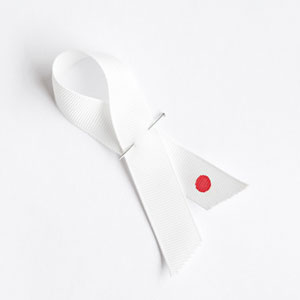A slow, painstaking recovery effort continues in the Tohoku region of Japan, which was ravaged on March 11 by a 9.0-magnitude earthquake and a 30-foot tsunami. Many architects are eager to help, whether that means raising money, lending design services, or mobilizing damage assessment teams.

London-based architect John Pawson has created a white ribbon marked with a red circle, akin to Japan’s flag. Virtual versions of the ribbon are available on Pawson’s website for a suggested donation of £1.
On March 30, architect Hisaya Sugiyama, head of Japan's chapter of the American Institute of Architects (AIA), sent a detailed and captivating letter to AIA members. In it, Sugiyama, who is principal of Tokyo’s Quincy Studio, put forward specific ideas about how the county should rebuild, especially with regard to its school gyms, which are now sheltering many of the country’s 170,000 displaced residents.
In those gyms, Sugiyama wants to add floors with radiant heat, insulation that can be removed from walls to double as bedding, and rings on walls from which ropes can be tied to hang dividing curtains.
Plus, when the rebuilding does start, “architects should provide leadership and creativity in master planning of old and new communities, propose extra safety measures in buildings of different types, and promote economical and eco-friendly solutions,” Sugiyama wrote.
Still, he notes that it may be a few months before architects can get involved. “Unfortunately, what we do as architects does not seem to be so urgently needed in the confusing reality of affected areas,” he wrote. (When contacted by RECORD, Sugiyama referred all questions to the letter.)
While architects may not be needed anytime soon, other hurdles may greet them down the line. Currently, it’s not permissible for foreign architects to perform even basic surveys in Japan without being licensed.
Still, that has not stopped Seattle-based architect Rachel Minnery from wanting to take action. Minnery chairs the AIA’s disaster assistance task force, which was created after Hurricanes Katrina and Rita devastated Louisiana in 2005. The group encourages architects to undergo Federal Emergency Management Agency (FEMA) training to learn how to properly assess building damage.
Ideally, any volunteers for Japan would come from the ranks of the 1,000 or so U.S. architects who have been trained through the FEMA program. So far, none has been deployed to Japan because no government agency or charity there has issued any specific calls for help from designers, says Minnery.
Along the same lines, the AIA has contacted state coordinators to identify potential volunteers among their membership, says Minnery, who would be part of the leadership team if any effort crystallized. For her own part, Minnery has reached out to about 150 of the FEMA-trained architects, who have been told to standby until they are needed.
One group that does appear to have made inroads into Japan is Architecture for Humanity (AFH), which by late March had raised $250,000 from corporate donors and other charities toward construction of a youth center in Sendai, according to a prepared statement. The group also plans to oversee the construction of “urban acupuncture” centers.
Plus, by late April, AFH, which raised $2 million for quake-ravaged Haiti, plans to establish an office in Sendai, the port city hit hard by the disasters. AFH co-founder Cameron Sinclair could not be reached for comment.
About 20,000 homes are needed to replace what was lost in Japan, and they could take months to build. Some architects are focusing instead on temporary dwellings, like the AIA chapter in Baton Rouge, Louisiana.
“We are keenly aware of how it feels” to be crushed by natural disasters, says executive director Kathleen Gordon, referring to Hurricanes Katrina and Rita. To help Japan, her 300-member chapter is raising money for ShelterBox, an international organization that provides large tents to dislocated families. By late March, the chapter had collected $600.
Interest in Japan’s rescue is coming from overseas, too. London-based architect John Pawson, who spent four years in Japan and has designed homes and shops there, has created a white ribbon marked with a red circle, akin to Japan’s flag.
Virtual versions of the ribbon, which can be attached to e-mails, are available on Pawson’s website for a suggested donation of £1. The money will go toward the Red Cross’s efforts in Japan. “It’s such a simple thing,” says Pawson. “You wonder why it has not been done before.”

Post a comment to this article
Report Abusive Comment